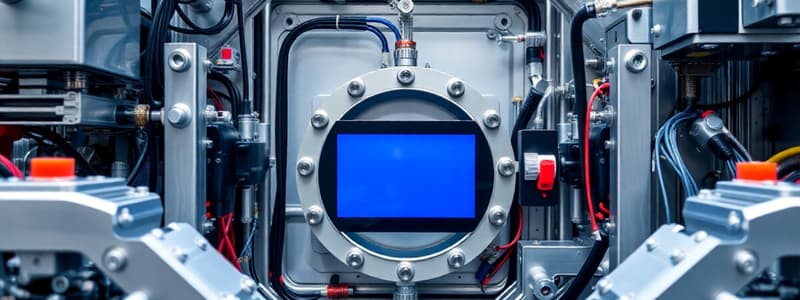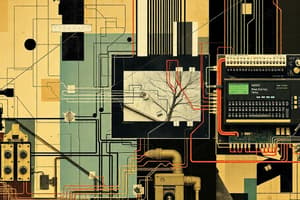Podcast
Questions and Answers
Which engineering disciplines are typically integrated in the field of mechatronics?
Which engineering disciplines are typically integrated in the field of mechatronics?
- Civil, telecommunication, and computer engineering
- Mechanical, electrical, and chemical engineering
- Aerospace, industrial, and software engineering
- Mechanical, electrical, telecommunication, control, and computer engineering (correct)
In the context of mechatronics, what is the primary focus of technicians?
In the context of mechatronics, what is the primary focus of technicians?
- Managing engineering projects
- Maintaining existing machinery (correct)
- Developing advanced control algorithms
- Designing new automated equipment
What is the overarching goal in the design and maintenance of automated equipment within the field of mechatronics?
What is the overarching goal in the design and maintenance of automated equipment within the field of mechatronics?
- Minimizing initial production costs
- Maximizing equipment complexity
- Producing safe and efficient automated equipment (correct)
- Achieving maximum speed regardless of safety
Consider a manufacturing plant implementing a new automated assembly line. Which role, within the mechatronics field, is MOST likely responsible for troubleshooting and repairing malfunctioning robotic arms on the line?
Consider a manufacturing plant implementing a new automated assembly line. Which role, within the mechatronics field, is MOST likely responsible for troubleshooting and repairing malfunctioning robotic arms on the line?
An engineer is tasked with designing a new robotic system for a manufacturing process. Considering the principles of mechatronics, what should be their primary approach?
An engineer is tasked with designing a new robotic system for a manufacturing process. Considering the principles of mechatronics, what should be their primary approach?
Flashcards
Mechatronics
Mechatronics
An engineering field integrating mechanical, electrical, control, and computing disciplines.
Mechatronics Professionals
Mechatronics Professionals
Includes engineers and technicians designing and maintaining automated equipment.
Roles of Technicians
Roles of Technicians
Responsible for maintaining automated machinery and systems.
Roles of Engineers
Roles of Engineers
Signup and view all the flashcards
Mechatronics Goals
Mechatronics Goals
Signup and view all the flashcards
Study Notes
Mechatronics Overview
- Mechatronics is a field of engineering that combines various disciplines, including mechanical, electrical, telecommunication, control, and computer engineering.
- The goal of mechatronics is to unify engineering disciplines in a design process.
- The mechatronics industry employs both engineers (design/development) and technicians (maintenance).
Career Options in Mechatronics
- Mechatronics professionals (technicians and engineers) work in labs, offices, or on-site manufacturing plants.
- Their aim is to build safe and efficient automated equipment.
- Technicians primarily maintain machinery, while engineers focus on component/product design and development.
Mechatronics Terms
- Accelerometer: Measures acceleration, often using piezoelectric materials.
- Actuator: Applies force or displacement within a system, especially in computer control.
- Alternating Current: Electric current whose direction oscillates.
- D/A Converter: Translates digital signals into analog voltage/current levels.
- Ampere: Unit for measuring electric current (flow of 1 coulomb/second).
- Analog: Continuous, relating to the real world.
- Asynchronous: Describes computer connections that can wait or be interrupt-driven.
- Battery: Combination of cells to produce electrical potential.
- Calibration: Comparing transducer outputs against reference standards.
- Capacitor: Stores electrical charge.
- Coulomb's Law: Describes the attractive/repulsive force between charged objects.
- Commutator: Device for reversing current direction.
- Diode: Electrical device allowing current flow in one direction.
- Electrical Conductor: Material allowing easy current flow.
- Electrical Insulator: Material preventing current flow.
- Electric Current: Flow of charge due to potential difference.
- Electrical Circuit: Conducting path for electrons between differing potentials.
- Electric Motor: Converts electrical energy into mechanical energy.
- Facility: A structure for a specific use (e.g., medical).
- Grounding: Provides a conducting path for electric charges to the ground.
- Hydraulics: Systems using fluid displacement for mechanical work.
- Hertz: Unit of frequency (cycles per second).
- Horsepower: Unit of power measurement (746 watts).
- Inductor: Electrical device resisting current change, creating a proportional magnetic field.
- Multiplexer: Equipment transmitting multiple signals on a single line.
- Parallel Circuit: Electrical circuit with more than one path for current.
- Potentiometer: Measures electric potential by comparison.
- Power: Rate of doing work (force x distance/time).
- Pressure: Force intensity (force/area).
- Resonance: Vibration at a system's natural frequency.
- Sampling: Converting analog signals to digital representations.
- Saturation: Nonlinear behavior in an electrical system reaches a max limit.
- Semiconductor: Material acting as an insulator but becomes a conductor with added energy.
- Series Circuit: Electrical circuit with a single path for current.
- Span: Algebraic difference in a range (zero to full scale).
- Spectrum: Plot representing a signal's frequency content.
- Tare: Deducted amount from gross weight.
- Thermistor: Device with resistance that varies with temperature.
- Transducer: Device transforming a physical stimulus to an electrical signal.
- Transformer: Device for increasing/decreasing voltage.
- Transistor: Semiconducting electrical device, often as an amplifier or switch.
- Transmitter: Device transmitting signals.
- Voltage Difference: Difference in electrical potential between two points.
- Work: The process of moving something a distance with force.
- Pneumatics: Branch of physics dealing with air and gas mechanics.
- Dielectric: Non-conducting substance/insulator.
Other Important Concepts
- Amplifier: Electronic component to boost power, current, or voltage.
- Digital: Using numerical digits (often binary).
- Mechanism: A collection of moving parts (often in machines).
- Resistance: Property opposing current flow in a conductor.
- Relay: Device switching circuits based on current or voltage changes.
- Optocoupler: Electronically transmits signals through light.
- Oscilloscope: Graphically displays voltage/current variations over time.
- Generator: Machine converting energy forms (often mechanical to electrical).
- Servomotor: Motor part of a control system.
- Controller: Remote hardware to manage electronic devices.
- Programming: Act of planning and writing code.
- Instrument: Device for measuring quantities.
- Driver: Software/hardware connecting computers to devices.
- Piezoelectric: Electricity produced by pressure/stress.
- Blueprint: Architectural/mechanical plan/outline.
- Maintenance: Caring for machinery/property.
- Measurement: Determining the dimensions or values of something.
Studying That Suits You
Use AI to generate personalized quizzes and flashcards to suit your learning preferences.




